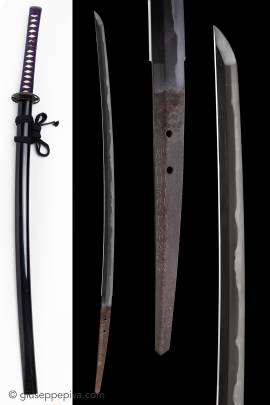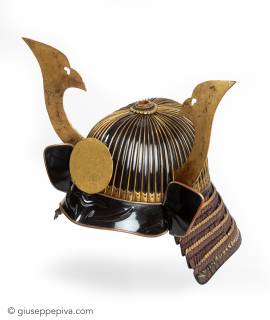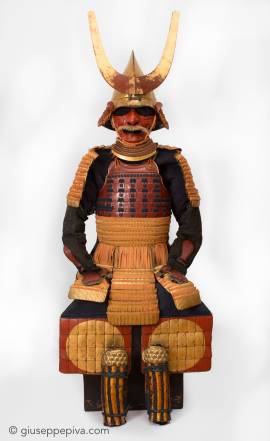Early Edo Period (1615-1867), circa 1650Signed 肥前國河内大掾藤原正廣Hizen kuni kawachi daijō Fujiwara MasahiroNBTHK Hozon Tōken Nagasa [length]: 72 cmSori [curvature]: 1.4 cmMotohaba [bottom width]: 2.9 cmSakihaba [top width]: 2.1 cmMotokasane [bottom thickness]: 5.5 mm Sugata [configuration]: Shinogi-zukuri, iori-mune, koshi-zori, chu-kissakiKitae [forging pattern]: Ko-itame hada and konuka hada typical of Hizen. Jinie.Hamon [tempering pattern]: Gunome midare in nie-deki with thick nioiguchi. Ashi, yō, long sunagashi and kinsuji.Boshi [point]: Round at the end with hakikake kaeriNakago [tang...
WORKS FOR SALE
Mid-Edo period (1615-1687)18th centuryThe helmet is of goshōzan shape, slightly raised at the back. It is composed of 62 vertical, slightly convex plates lacquered in black urushi. Each plate is bordered by a gilt copper border in the sō-fukurin style. This style of decoration was introduced by the armorers of the Haruta school during the Muromachi period (1336-1573) for their akoda-nari kabuto and, in addition to the aforementioned fukurin, provides for shaped gilt ornaments at the base of each plate (higaki). The tehen-no-kanamono that adorns the top of the helmet is five-tiered. The visor...
Dangae-dō tosei gusokuAssembled red and gold lacquer Japanese samurai armor PERIODEarly Edo period (1615-1868), 17th CenturyPROVENANCE Ii Naomasa This authentic samurai armor seems to belong to the "Red Devils" samurai of Ii Naomasa, who used to wear red lacquered (shu-urushi) armor with large golden stylized horns on the kabuto. The armors of the Ii retainers were also red, together with banners and accessories, hence taking the name of “Ii no akazonae” (“the red equipment of Ii”).This interesting samurai armor shows two...
Copyright © 2016 - giuseppe piva - VAT: 05104180962










